After 3 epic days on the Great Wall of China from Beijing, we set off toward our second stop in a major Chinese city: Xi’an, capital of Shaanxi Province. So after taking our first night train in China, we arrived bright and early in this city of nearly 12 million inhabitants. After Beijing and its 22 million, it almost seemed small. Well, we quickly put things in perspective when we realized that Xi’an still has more inhabitants than our dear little Switzerland in its entirety… 😉 To explore a good portion of the historical and cultural attractions, we decided to take our time by staying several days. What to do in Xi’an in 3-4 days? Follow the guide for visiting the city!
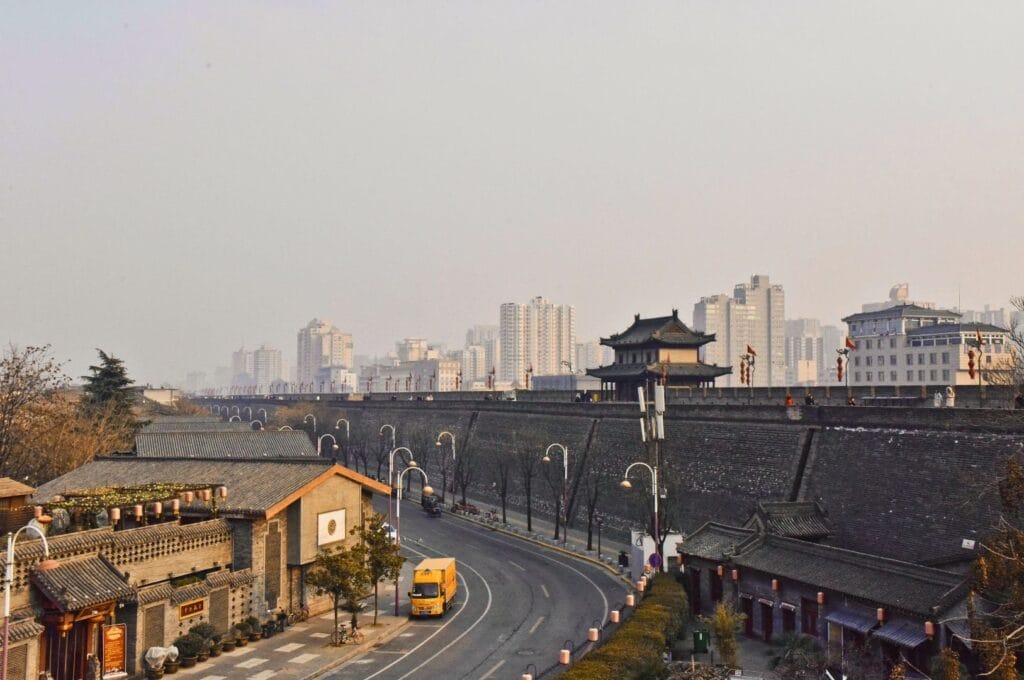
- How to get to Xi’an from Beijing
- Where to stay in Xi’an
- Strolling through the Muslim Quarter (Hui Quarter)
- Walking around the Bell Tower and Drum Tower
- Touring the ramparts on foot or by bike
- Visiting the Big Wild Goose Pagoda
- Learning at the Shaanxi Province History Museum
- Admiring the Terracotta Warriors
- Tasting local specialties of Xi’an
- Climbing to the summit of Mount Hua (Huashan Mountain)
- Other activities to do in Xi’an
- Quick review after more than 2 weeks of travel in China
We visited Xi’an in 2013, but the article has been completely reviewed and updated in June 2025. If you notice any price changes or have additional information that could be relevant, please don’t hesitate to leave us a comment!
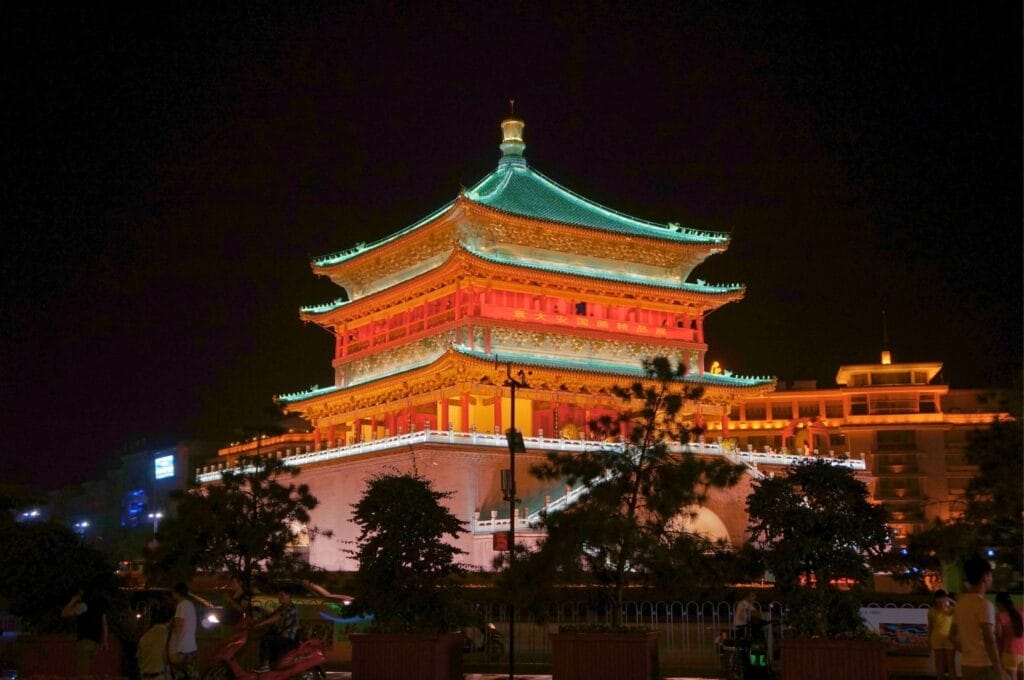
How to get to Xi’an from Beijing
We arrived from Beijing by train. To reach Xi’an, the train is really the simplest means of transport! However, you should know that trains aren’t necessarily cheap in China, or at least they follow a very simple rule: the faster it is, the more expensive it gets!
To get to Xi’an from Beijing, you have roughly 2 options:
- Express train: Takes between 4 and 6 hours and costs between 60 and 200 euros, depending on the category. Each day, more than 15 high-speed trains run on this line.
- Night train: This one takes between 11.5 and 17.5 hours… But they’re much cheaper! In seated classes, prices start at around € 20. However, sitting for 15 hours is tough! In sleeper class, the price depends on the category, but generally oscillates between 40 and 60 euros. Find schedules online.
For our part, we took the night train. Unfortunately, there were no more hard sleepers (the cheapest sleeper option) available and we ended up buying last-minute tickets in soft sleepers (the most expensive sleepers) for nearly 60 euros per person. Ouch!
Even if the difference between the night train and the express isn’t huge, the night train offers the advantage of saving a night’s hotel stay. Yes, every little saving counts! And let’s be honest, in the soft sleeper category, you sleep like a baby!

This article contains affiliate links to partner sites. When you use our links to book accommodation, a car, or an activity, you don’t pay anything extra, but we get a small commission. This helps us to offer you free, independent, and ad-free content. Thank you for your support!
Where to stay in Xi’an
To look for a hotel in Xi’an, we recommend going through Booking. To give you a good address, we were in Xi’an with Sabine, Benoit’s sister. We took a triple room at the Hantang Inn Hostel and we recommend it! The night isn’t very expensive, it’s clean and well-located, breakfast is included. And if you prefer hostels, then we warmly recommend the Sifang Space Hostel. The price is almost unbeatable for a super clean and comfortable hostel with a central location. Bonus: the staff speaks French ;). Favor accommodations near the ramparts, in the old town, to be central.

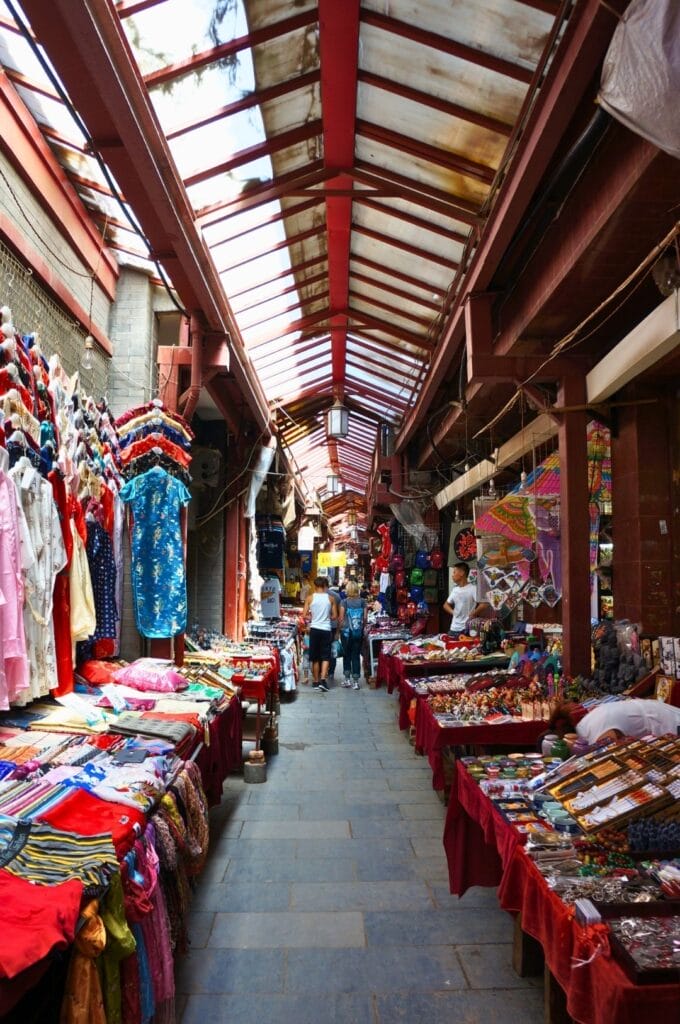
Strolling through the Muslim Quarter (Hui Quarter)
You may already know this, but Xi’an was located at the far east of the famous Silk Road. As a result, there’s a fairly significant Muslim community in the heart of this fortified city. Most Muslims are indeed descendants of Arab or Persian merchants who traveled this ancient trade route in the Middle Ages.
The Great Mosque
In the center of the historic downtown is Xi’an’s Great Mosque, which can be visited for 25 yuan. The entrance fee only applies to non-Muslims. We really enjoyed visiting this mosque, which had almost nothing in common with those we know. Its style was very heavily influenced by Chinese culture. Even the minaret located right in the center honestly reminded me more of a small temple than anything else!

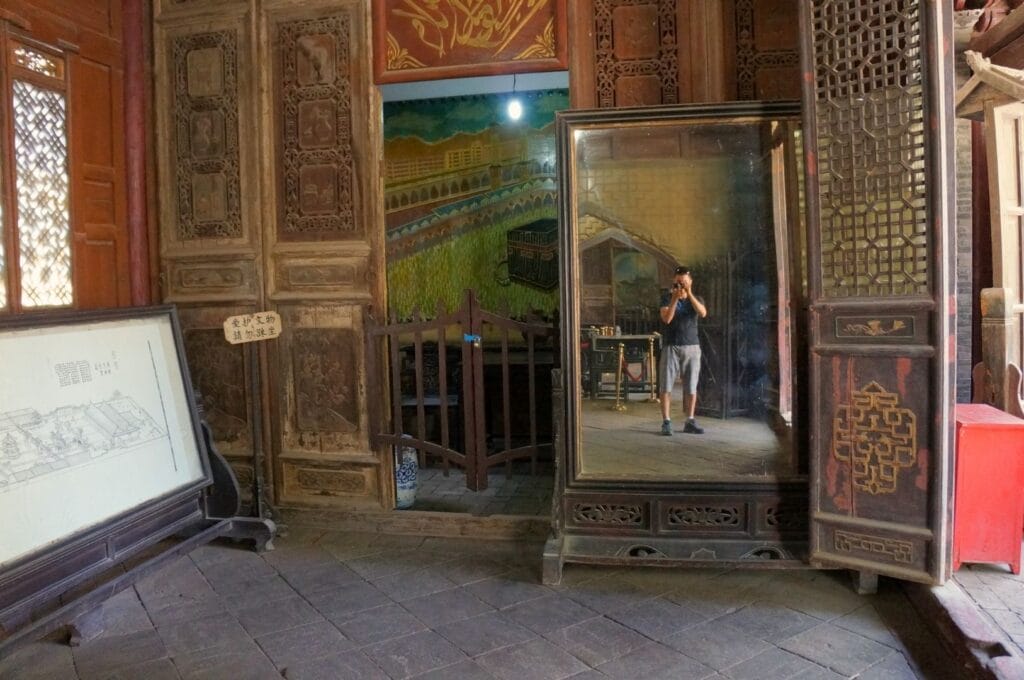
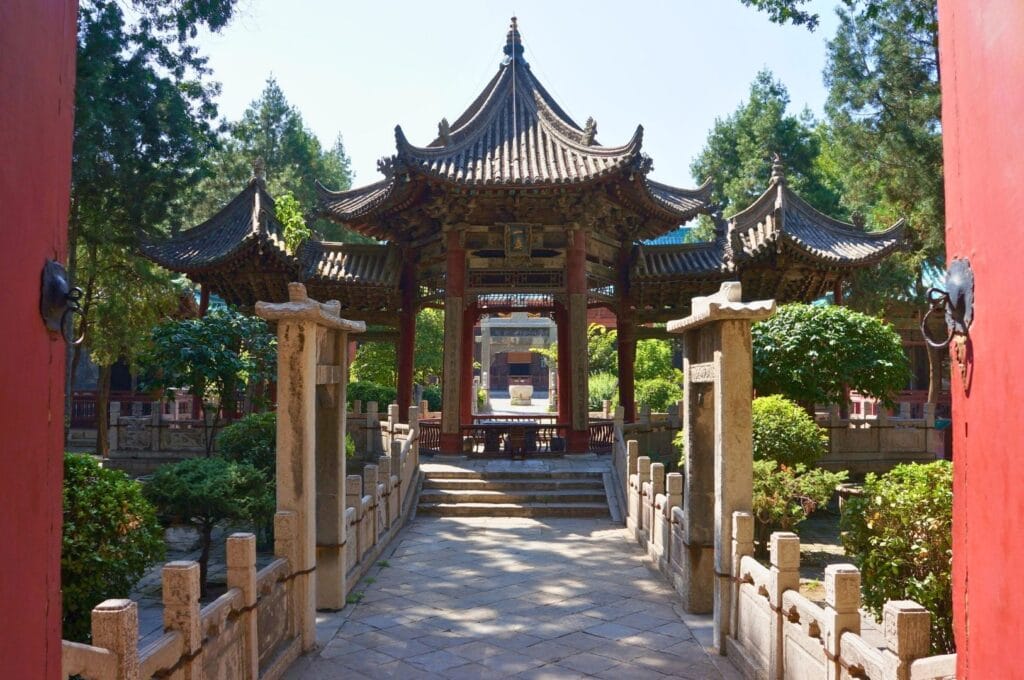
The food
In the evening, the Muslim quarter is very nice and very lively. It’s actually one of the best neighborhoods in Xi’an to grab a bite in the evening or do some shopping in the afternoon. Since our hostel was located just steps away, we spent most of our evenings there strolling and discovering new flavors. We even tasted our first yangrou paomo there, a typical Xi’an soup made with mutton and pieces of bread. Not exactly fine dining, but an interesting discovery, let’s say ;). We’ll go into more detail about Xi’an food later. Browse the main Beiyuanmen Street and get lost in the adjacent streets.
In any case, in terms of street food, markets, music, and crowds, the Muslim quarter has everything you need! In short, we recommend spending at least one evening in these streets for a beautiful cultural mix.
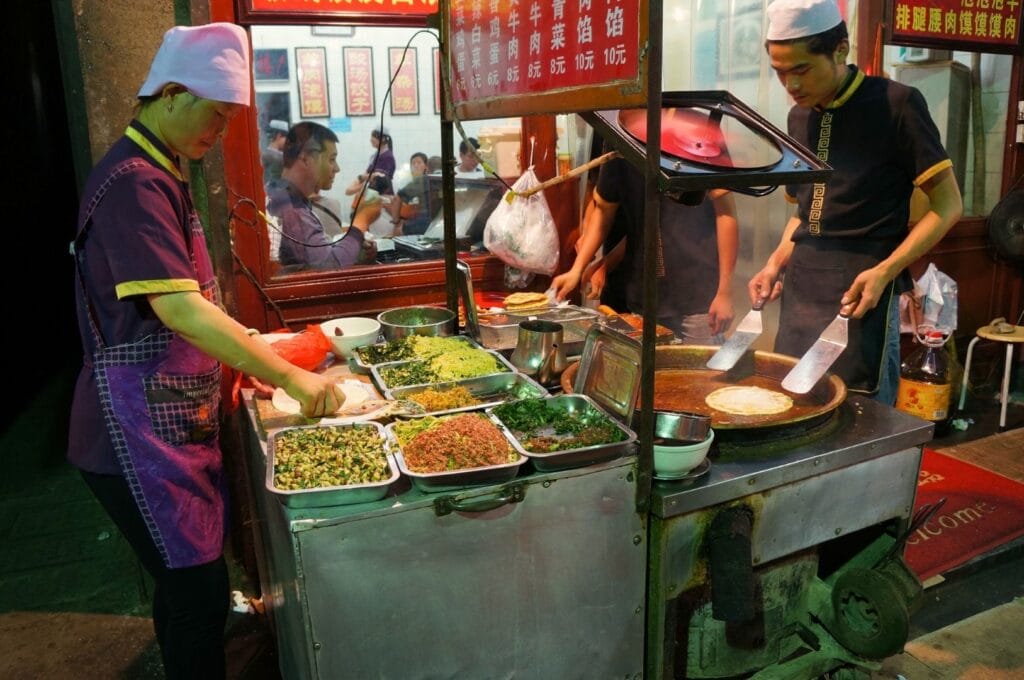
Walking around the Bell Tower and Drum Tower
The Bell and Drum Towers were both built in Xi’an in the 1380s during the Ming Dynasty. They are in some ways the symbols of the city and sit right in the center, just steps from the Muslim quarter. The Bell Tower is located right in the middle of the roundabout just north of the south gate (Yongning Gate) of the ramparts, and the Drum Tower is less than 300 meters west of the first.
These two towers can be visited, but honestly, we preferred to keep that budget (about 50 yuan) to treat ourselves to a good meal. However, we really recommend passing through the neighborhood once night falls. The two towers are then magnificently lit up and are definitely worth seeing!
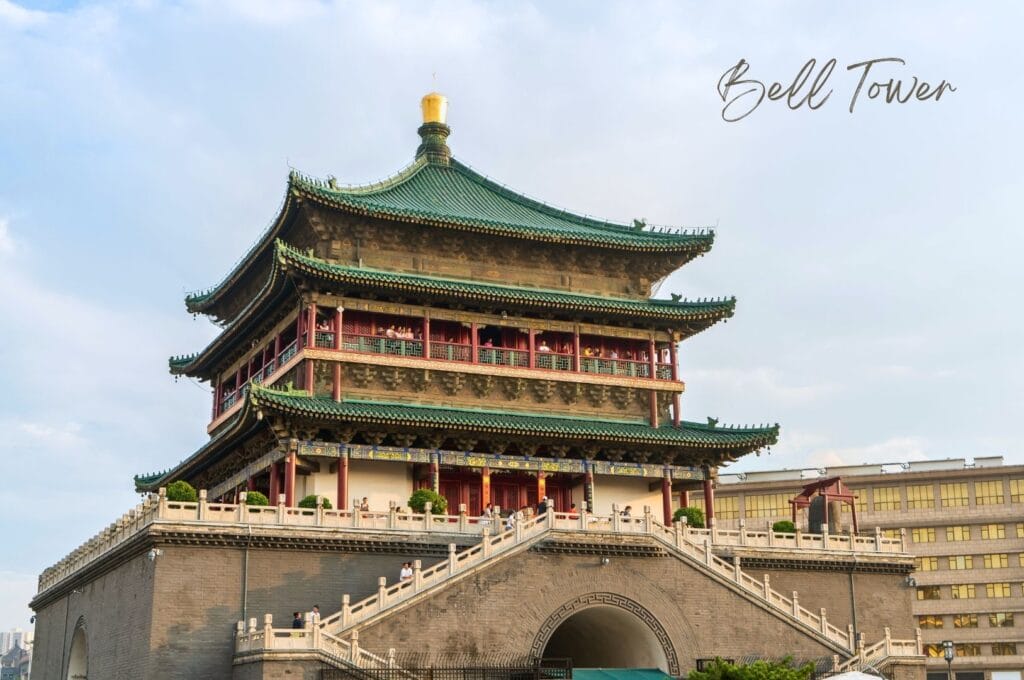
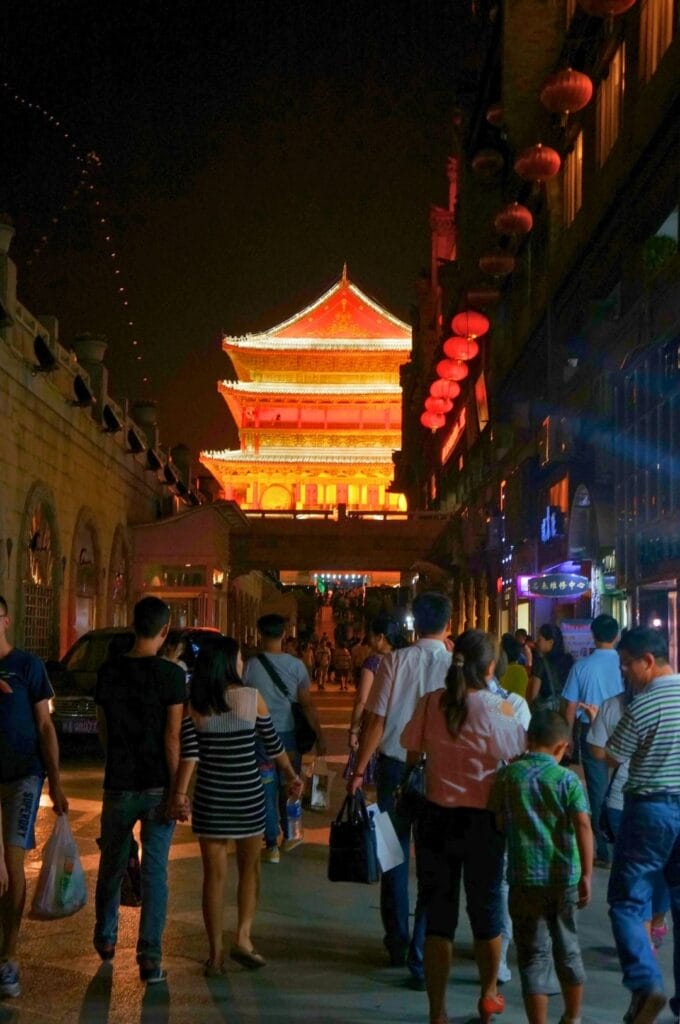
Touring the ramparts on foot or by bike
Xi’an’s old town is still surrounded by ramparts that can be visited without problem. This ancient city wall is considered the best preserved in all of China! To climb up, you’ll need to pay the 54 yuan per person ticket. Then, the fortifications with a total length of 14 km will be all yours (or almost). Indeed, this tour is much less crowded than the rest of the city’s tourist sites, so it’s an excellent way to find some peace and quiet in the big city frenzy.
You can very well walk around it, but cycling is especially popular. The classic ramparts tour starts from the south gate and bike rental costs 45 yuan per person (you’ll find rental shops all around the fortifications). If you’re lucky, you might have the chance to find a tandem (90 yuan rental)! Allow 2 hours to go around. The ramparts are open to the public from 8 a.m. to 7 p.m. and the south gate closes at 10 p.m.

Don’t miss the ramparts that light up when the sun sets, like the towers and pagodas in the city center.
Tip: Buy a combo ticket for 100 yuan per person to visit the Beilin Museum (the Forest of Steles) right next to the south gate (Yongning Gate).
Visiting the Big Wild Goose Pagoda
Another symbol of Xi’an and a UNESCO World Heritage monument, the Giant Wild Goose Pagoda was initially built in 652 AD to protect Buddhist writings from India. It was rebuilt in its current version in 704. At 64 meters high (and with its slight Leaning Tower of Pisa air!), the pagoda is a magnificent building in itself, but what drove us to discover it once night fell was the sound and light show around the fountains that takes place right in front every evening of the week at 9 p.m. The show is truly impressive, and it only confirms once again this idea that has followed us since the beginning of this trip: the Chinese don’t do things halfway!
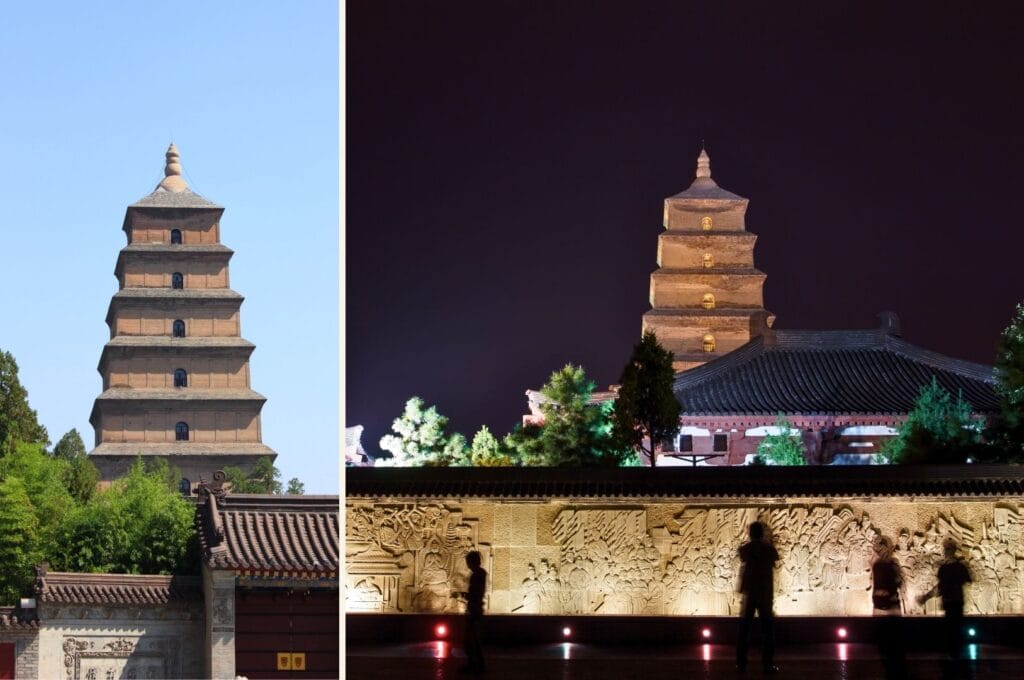
To give you an idea, the show takes place in a fountain that is nonetheless the largest fountain in Asia, with its 6,500 m2 of surface area. Just that! Needless to say, the show is very much appreciated by the Chinese, and you won’t exactly be the only ones watching the spectacle… Despite the fountain’s size, we really had to elbow our way through to see something. But as usual, the show was happening as much around the Big Wild Goose Pagoda as within the crowd! We had a blast watching the Chinese pose with their rabbit ears or other clothing fantasies.
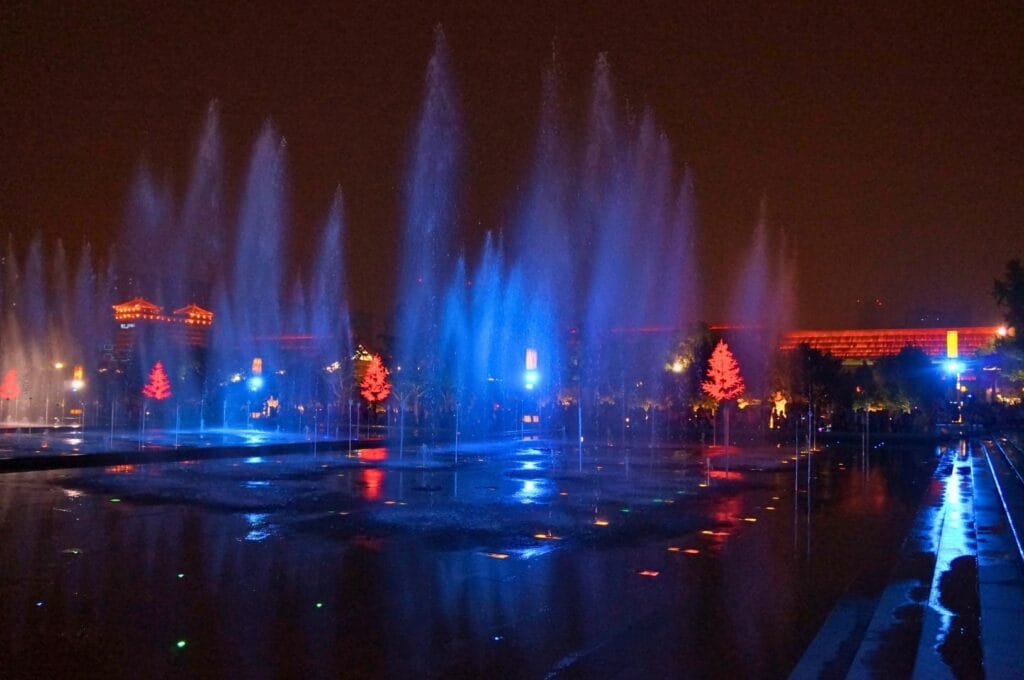
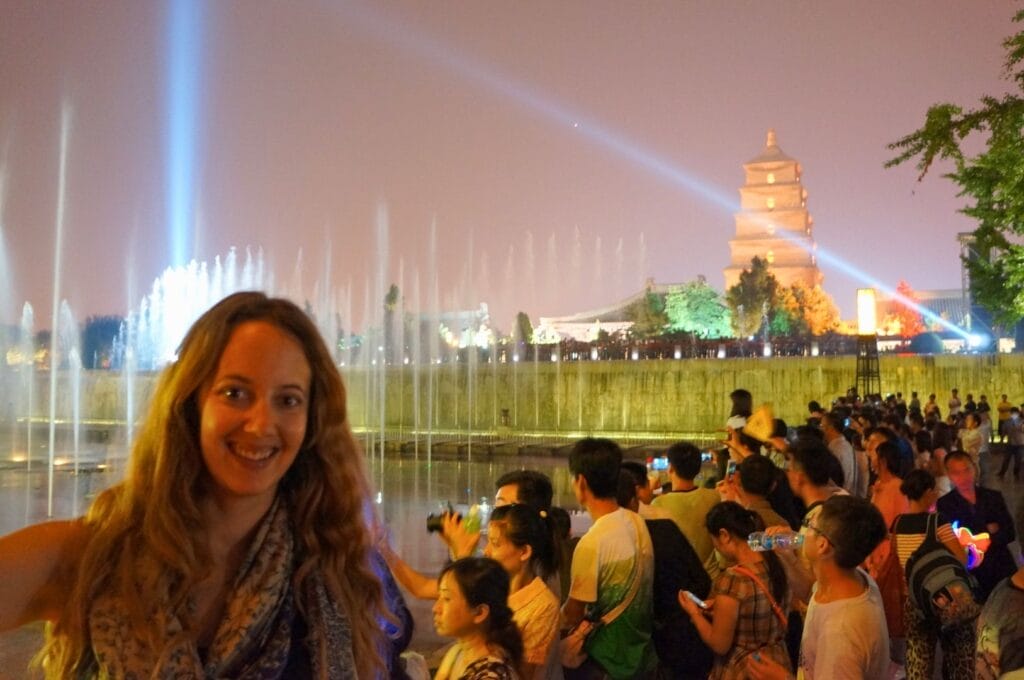

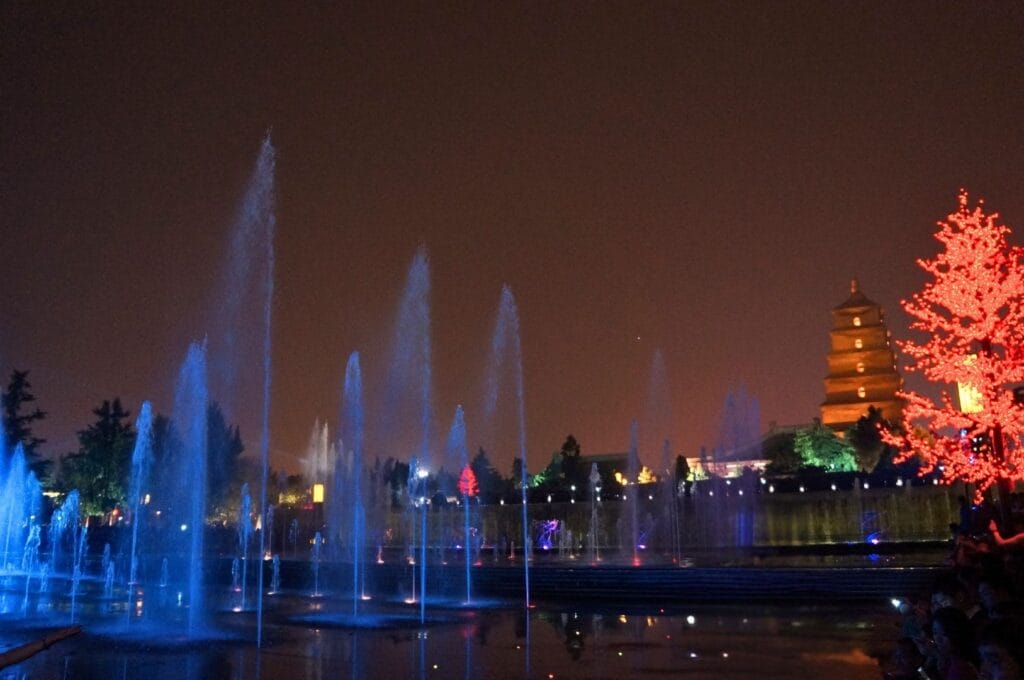
- How to get there: The Wild Goose Pagoda is located south of downtown. Take metro line 3 or 4 and get off at Dayanta station.
- Ticket: The pagoda is located within the Da Ci’en Temple grounds and access costs 30 yuan. To climb up, you’ll need to pay an additional 20 yuan. The free fountain show starts at 9 p.m. and lasts about twenty minutes.
Learning at the Shaanxi Province History Museum
In China, there’s a history museum in each region, and obviously, Shaanxi Province is no exception to the rule. You should know that provincial history museums in China are systematically free! To enter, you just need to present your passport number (or be creative in inventing one if you don’t have your passport with you :)). Located next to the Giant Wild Goose Pagoda, we warmly recommend visiting the Shaanxi History Museum before attending the nighttime show. The exhibitions were very interesting, the rooms follow one another and you learn a little more each time about the great dynasties that reigned as well as the development of the Silk Road while admiring the nearly 300,000 pieces on display.
- Museum opening hours: It’s open every day from 8:30 a.m. to 7 p.m., last entry at 5:30 p.m.
- How to get to the Shaanxi History Museum: From downtown Xi’an, take metro line 2 or 3 and get off at Xiaozhai stop, you’ll be 600m on foot.
- Tickets: Entry is free, but there’s a daily visitor quota. You can reserve your ticket at the counter the day before or via WeChat. Tip: come early to avoid the biggest crowds!
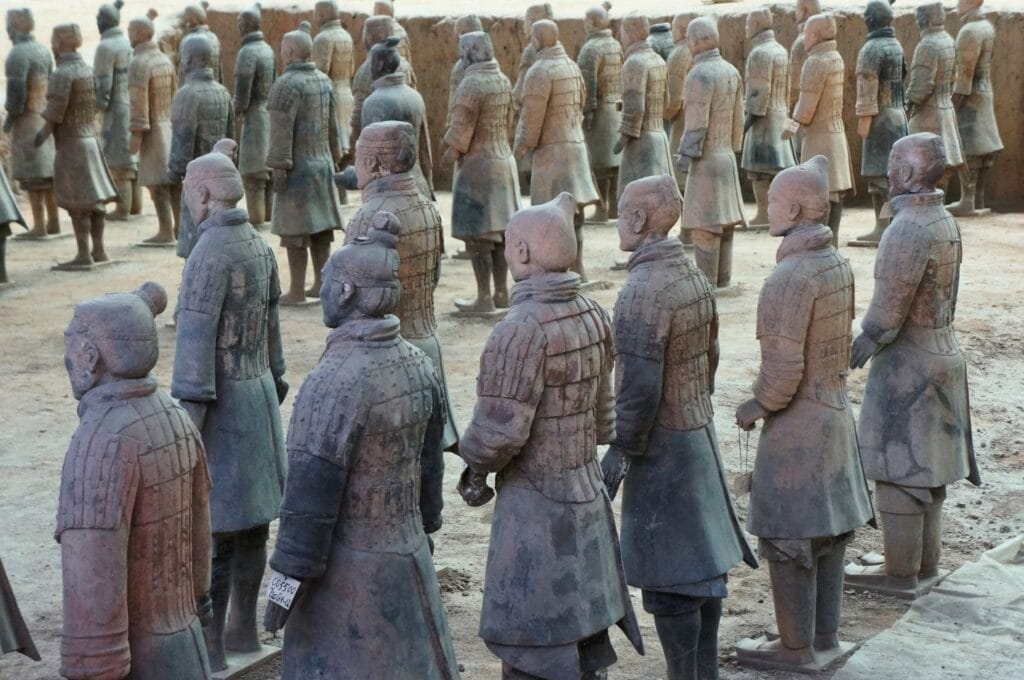
Admiring the Terracotta Warriors
The Terracotta Army Museum is probably THE most famous tourist site in the region. Located within the grounds of Emperor Qin Shihuang‘s mausoleum, it’s also one of the most visited places in the country after the Great Wall of China! Being in the area, we couldn’t pass up this UNESCO World Heritage archaeological treasure!
How to get to the Terracotta Warriors Museum from Xi’an
The mausoleum and its warriors are located on the outskirts of Xi’an, 1 hour by road from downtown. To get there, you have several options: go by public transport independently or take part in an organized tour with a guide.
By bus
The simplest (and cheapest) way to see the terracotta soldiers is to take the bus. For that matter, it’s quite simple to reach the museum on your own! All buses start from Xi’an railway station, east wing. To get to the Terracotta warriors, you need to take tourist line 5/bus no. 306, it’s written: 5 (306) in general. Warning: when arriving at the station square, you might well get harpooned by fake bus drivers or fake police. Don’t follow anyone and look for the 306 bus sign/platform yourself. Since this line is official, no official driver amuses themselves by fishing for tourists ;). The first ones leave for the museum at 7 a.m. and there are several departures per hour. If you want to know the exact schedules, don’t hesitate to ask your hostel. Allow 45 minutes to 1 hour travel time for a bus ticket at 10 yuan per person.
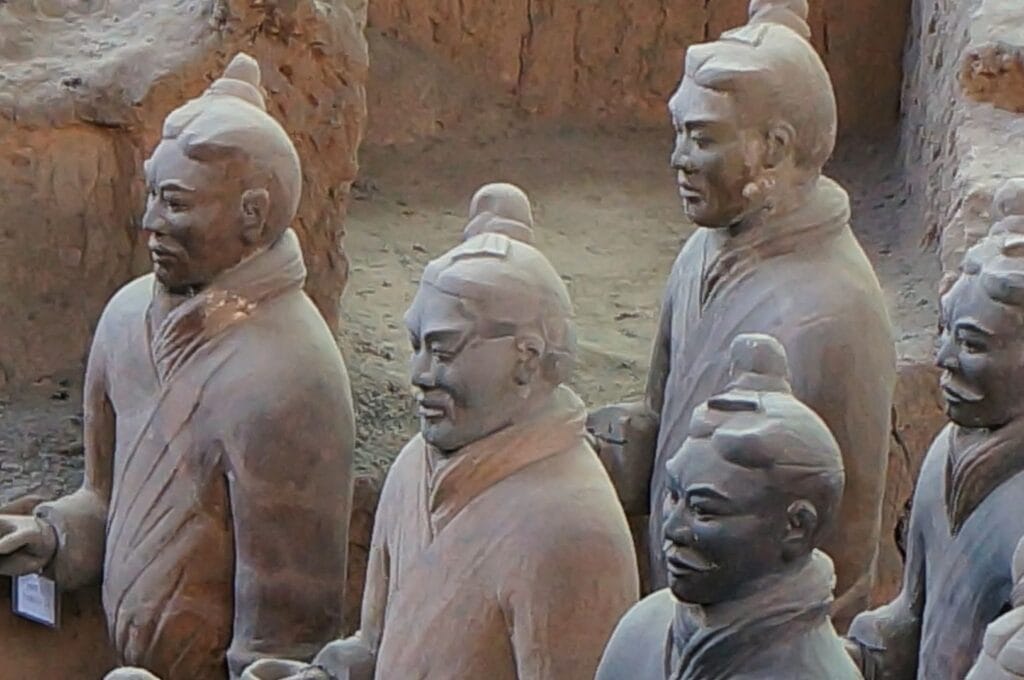
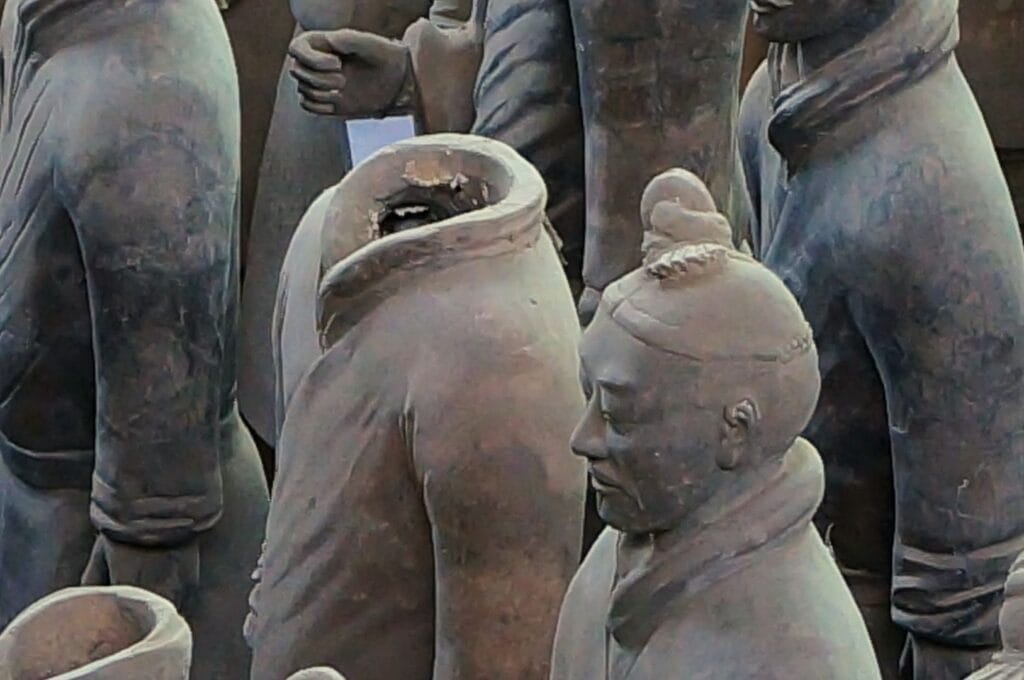
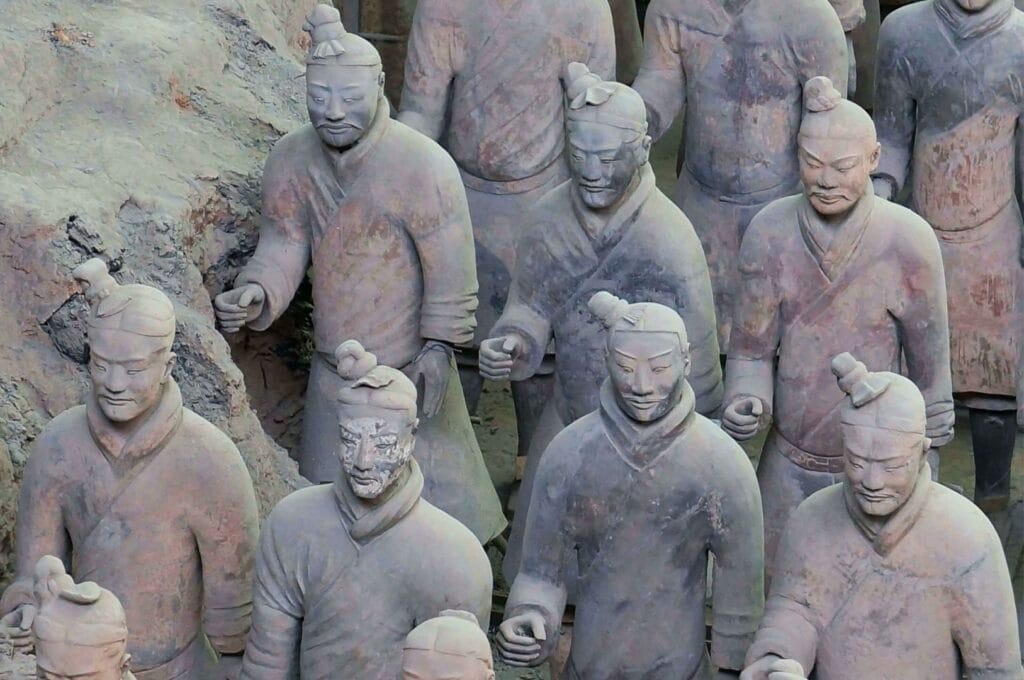
With a guided tour
You’ll find many hotels, hostels, and agencies offering an excursion from downtown. Among them, we recommend 2 tours. This one lasts a good half-day and you only visit the terracotta army. In our opinion, it’s a very good value for money – you have transport, tickets, lunch, and guide included. This one takes you through several Xi’an tourist sites during the day: the Terracotta Warriors Museum, the Giant Wild Goose Pagoda, and the old town ramparts. It’s perfect if you’re only planning to spend 1 or 2 days in the area.
The History
Before talking about the visit, let’s do a little summary of the history of this incredible terracotta army. It’s Qin Shi Huang (Qin Dynasty), the 1st emperor who unified China in the 3rd century BC, who is behind this somewhat crazy project. His idea was to build a real army so that it would protect him after his death, in the afterlife. This is how the construction of the Qin Shihuang mausoleum site began. This pharaonic construction site lasted 36 years and mobilized more than 700,000 workers!
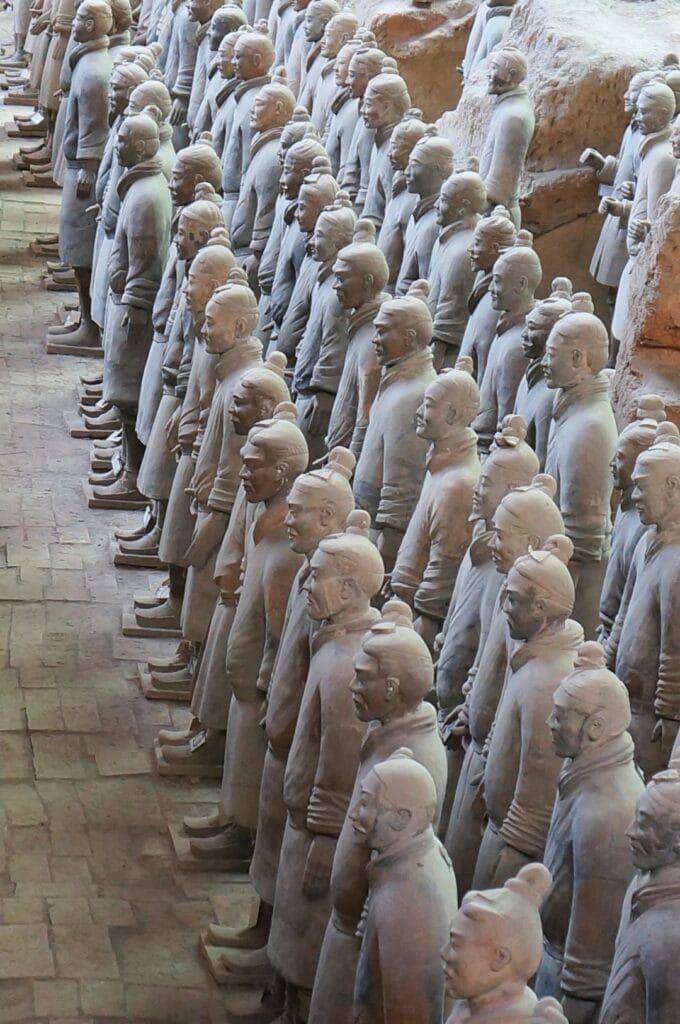
These clay warriors were discovered recently and completely by chance! In 1974, farmers found terracotta pieces while digging a well. Thus, archaeologists conducted excavations in the sector and revealed the existence of several pits over more than 56 km2 with thousands of buried statues!
To find out more about the history of this archaeological site, visit the UNESCO page.
The guide
To be honest, taking a guide in this place is almost an obligation. For once, the Chinese aren’t particularly good at English translations in tourist sites.
And paying 120 yuan just to admire the terracotta soldiers seems a bit expensive for the plot of land, if you ask me! You can always take an audioguide, but it seems the explanations aren’t great.
Therefore, you have the choice of taking a guide on site or booking your visit online (with or without transport from Xi’an). On our side, our guide was extremely open. The tour lasts about 2 hours and we were able to ask her all sorts of questions about the warriors, of course, but also about China in general.
Note: If you prefer to visit on your own, we recommend buying your tickets online the day before, or even several days in advance. These skip-the-line tickets will allow you to arrive first thing to enjoy the site!
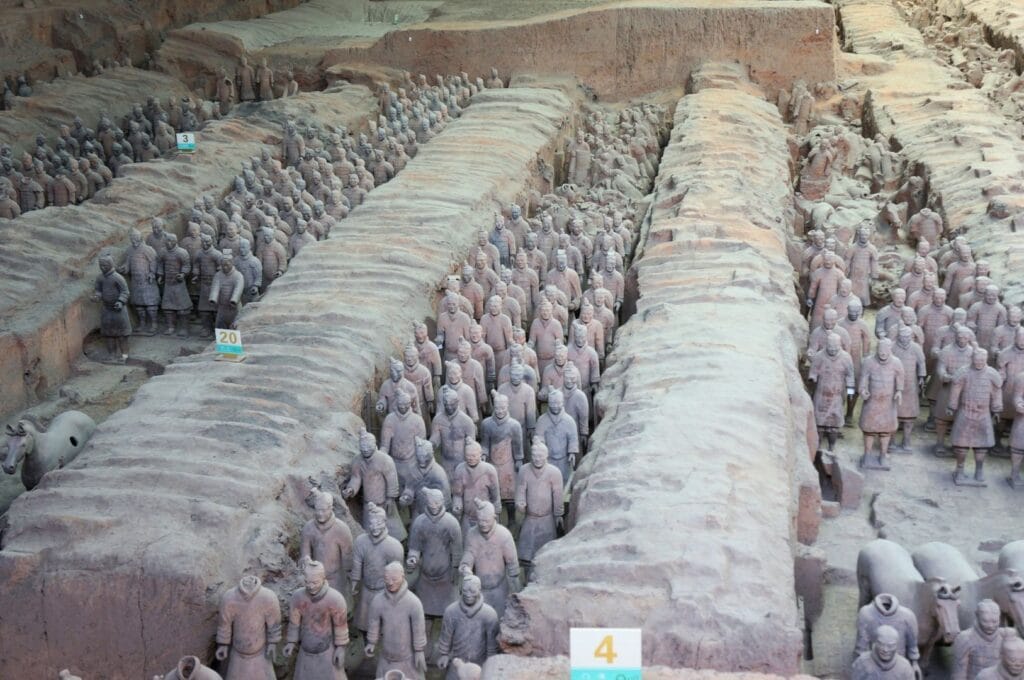
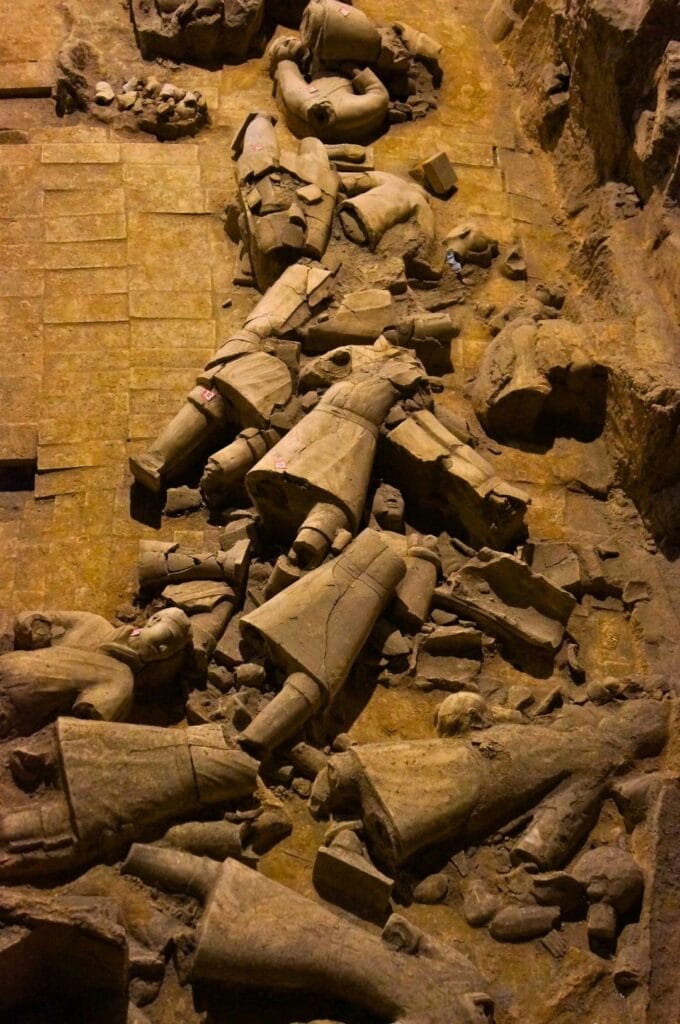
The visit
Time for the visit! So, the site is divided into 3 main pits:
- Pit 1: At more than 200 meters long, it’s the main pit with 2,000 figurines: soldiers (all different!) lined up in ranks, chariots, cavalry and life-size horses. The whole thing is aligned in attack position for a potential battle.
- Pit 2: Smaller than pit 1, pit 2 includes archers, horses, and infantry.
- Pit 3: It’s the smallest of the pits, the equivalent of the command post with the officers.
Next to pit 1, don’t miss the exhibition hall with its magnificent bronze chariots!
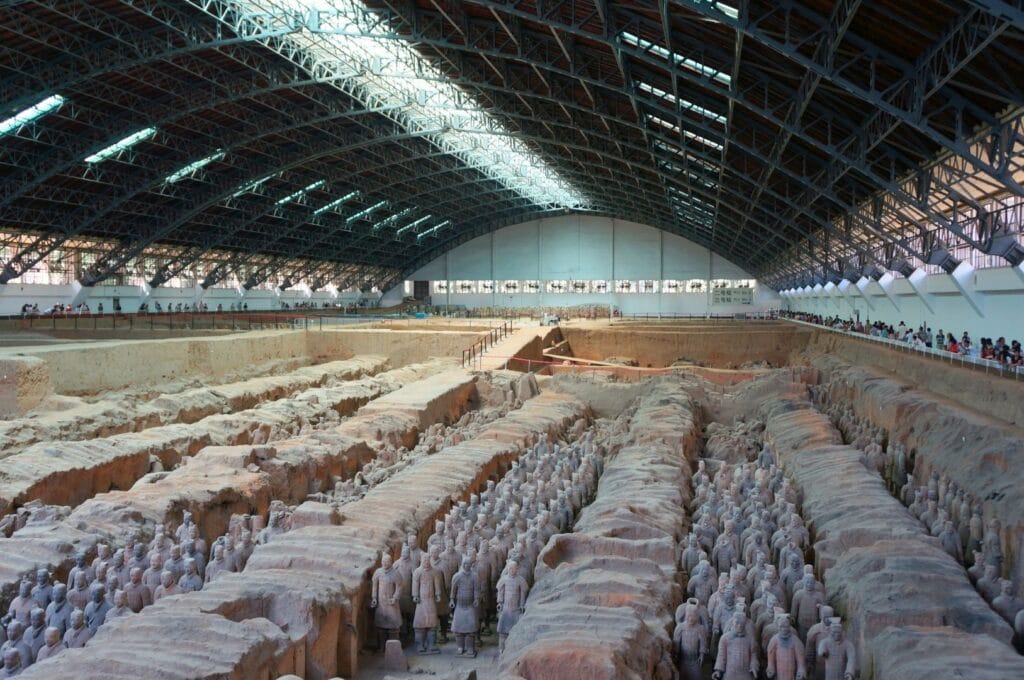
The work that was accomplished at the time is just impressive! And what we see is actually just the tip of the iceberg. For example, in pit 1, about 2,000 life-size horses and soldiers are displayed to the public. In reality, the site houses more than 6,000! But many clay statues are still buried because, initially, they were all painted! Obviously, daylight made the soldiers staring at tourists lose their color. It was therefore decided to wait for future technological advances in archaeology and especially preservation of finds before continuing to dig trenches. In the gallery, you see what the colored statues looked like during excavation.
In short, you’ll have understood, this clay army is really worth making the trip to Xi’an!
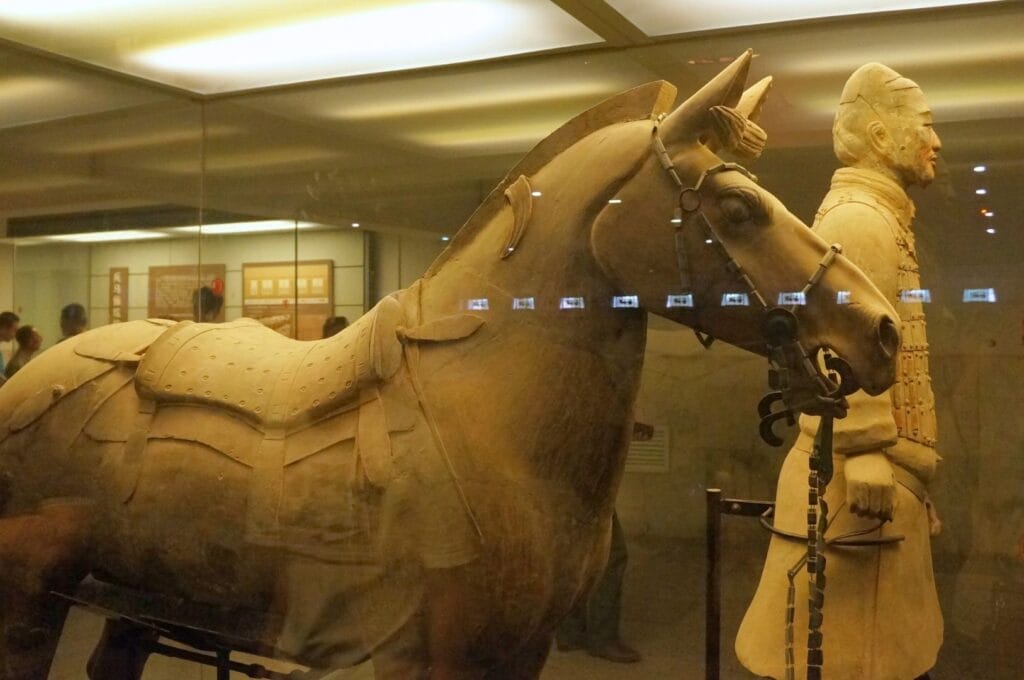
Tips and practical information before visiting
- The Terracotta Army Museum is open every day from 8:30 a.m. to 4:30 p.m. from December to February and from 8:30 a.m. to 5 p.m. from March to November.
- Allow a good half-day for the visit.
- Entry alone to the site costs 120 yuan. To avoid queuing and since there’s a daily entry quota, we recommend buying skip-the-line tickets before your visit. This ticket includes entry to the Qin Shihuang Mausoleum (the tomb) in the heart of a park, located 1 km from the pits. A free shuttle takes you from the site entrance to the funeral complex.
- The site is as popular with locals as with tourists. So avoid weekends and holidays in China, namely the first week of October.
- To enjoy it best, prefer to visit as soon as it opens. You won’t be alone, but there will be fewer people. Noon can also be a good time ;).
Tasting local specialties of Xi’an
Xi’an is considered a gastronomic city, given that it brings together all the cuisines of Shaanxi Province. Already, the Muslim quarter showcases street food and delicious specialties. We’ll notably mention:
- Roujiamo: Considered the Chinese hamburger, it consists of bread stuffed with meat and vegetables;
- Liangpi: Liangpi are cold noodles accompanied by peanut sauce with cucumber and coriander
- Yangrou paomo: Xi’an’s emblematic dish, this mutton soup is served with bread that must be crumbled into the soup
- Biang biang mian: Another pasta dish, biang biang mian is thick noodles served with spicy sauce, vegetables, and meat
To taste the city’s must-try dishes, we recommend getting lost in the Muslim quarter’s alleys or taking part in this food tour with a guide. The Chinese cuisine of Shaanxi Province will have no more secrets for you ;).
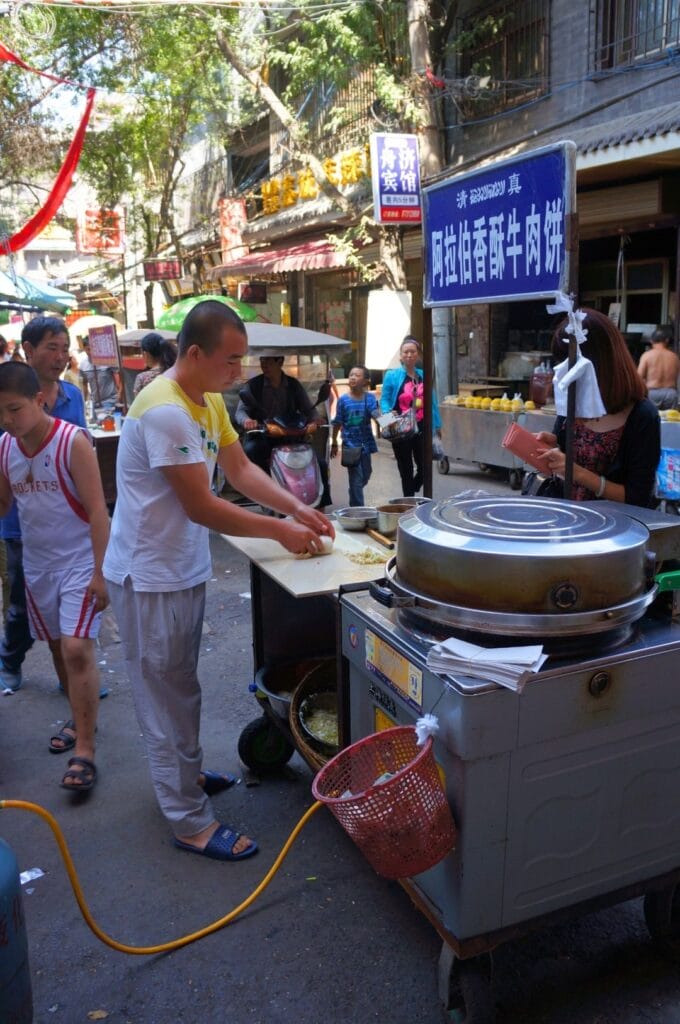
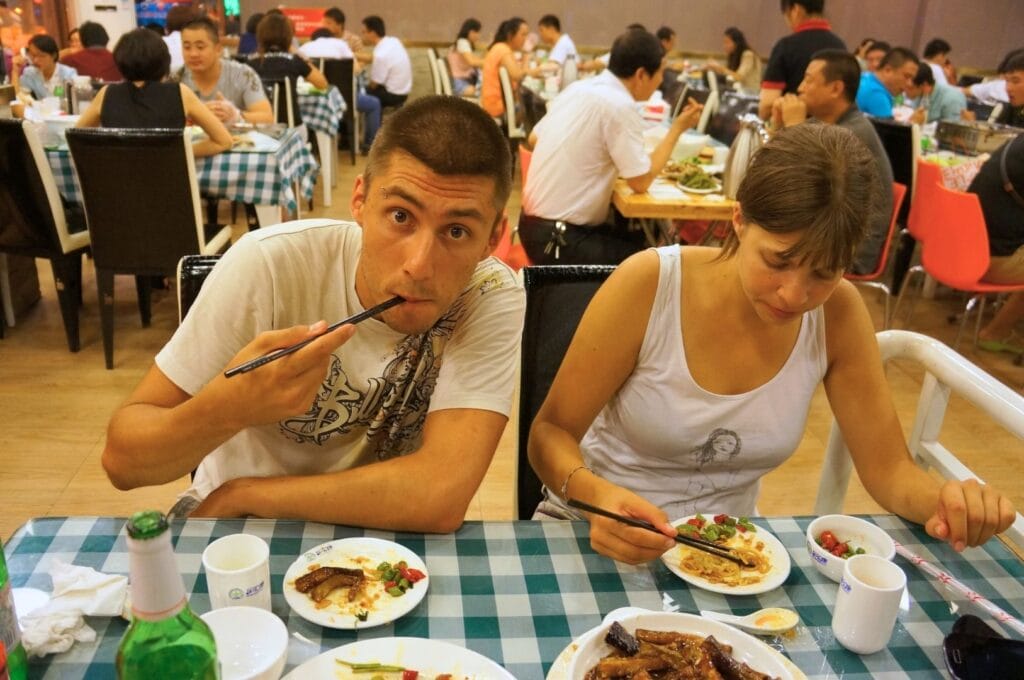
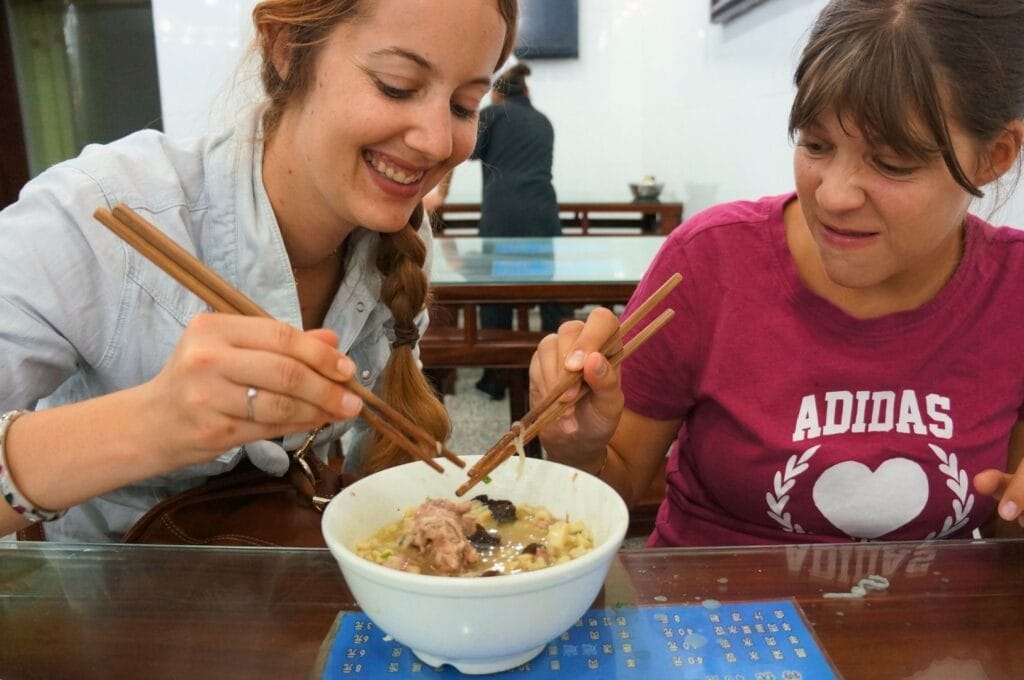
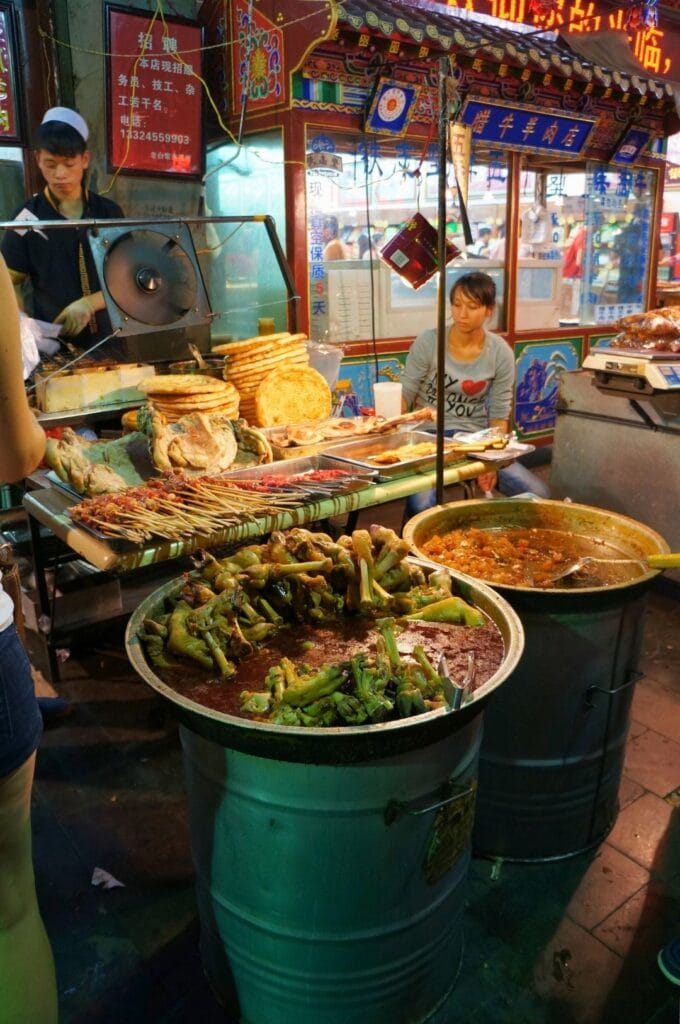
Climbing to the summit of Mount Hua (Huashan Mountain)
Plan a day or 2 to enjoy Mount Hua or Huashan, one of China’s 5 sacred mountains and a former major pilgrimage site. We chose to climb the north peak (1,615 m altitude) and this ascent was sporty! Also, we understand now why they say the trail is one of the most dangerous in the world. But don’t panic, there are other safe ways to get to the top! We explain how to make the ascent of Mount Hua in this article. You’ll find all the practical information (transport, accommodation, hikes…). On the program: splendid landscapes, a bit of adrenaline, and lots of sore muscles!
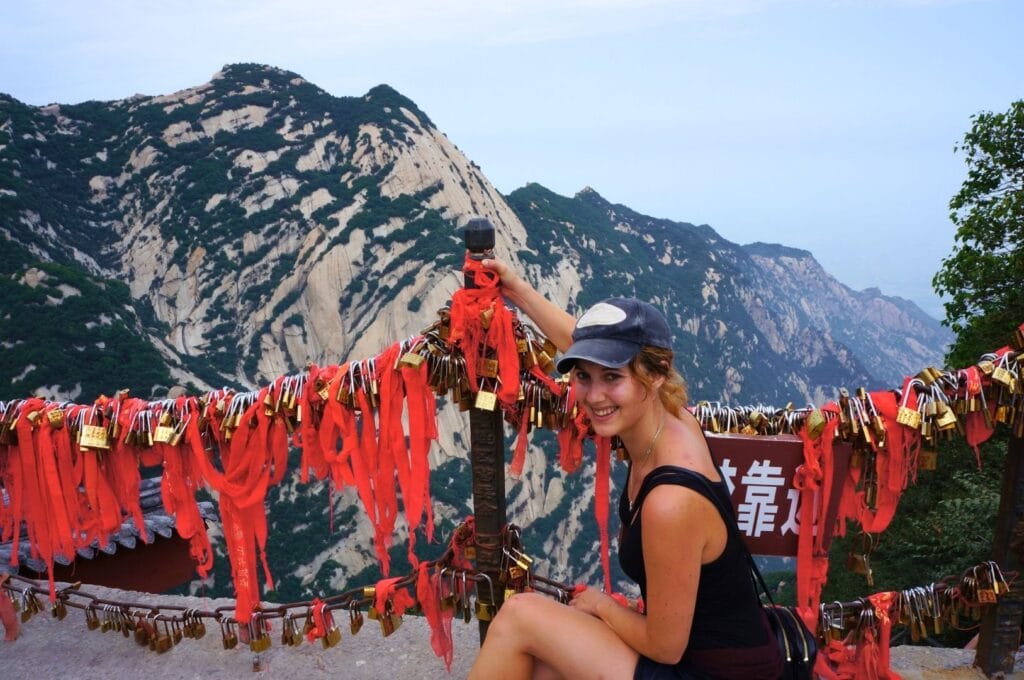
Other activities to do in Xi’an
If you’re short on ideas to build your itinerary or if you’re staying more than 3 days in Xi’an, here are some additional activities to do around Xi’an.
Visit Huaqing Palace
You can couple the visit to Huaqing Palace with that of the terracotta army, located 10 km away. This historic site brings together palaces and imperial baths dating from the Tang Dynasty, all on the slopes of Mount Li. Its highlight is the evening show, The Song of Everlasting Sorrow.
We don’t necessarily recommend making the trip just for that, but rather being in the vicinity of the terracotta army to stop by. Entry costs 120 yuan and the nighttime show ticket costs around 360 yuan, depending on the section. Tip: this show is very popular, book in advance! To get to Huaqin from Xi’an, take metro line 9 and get off at Huaqing Pool stop.
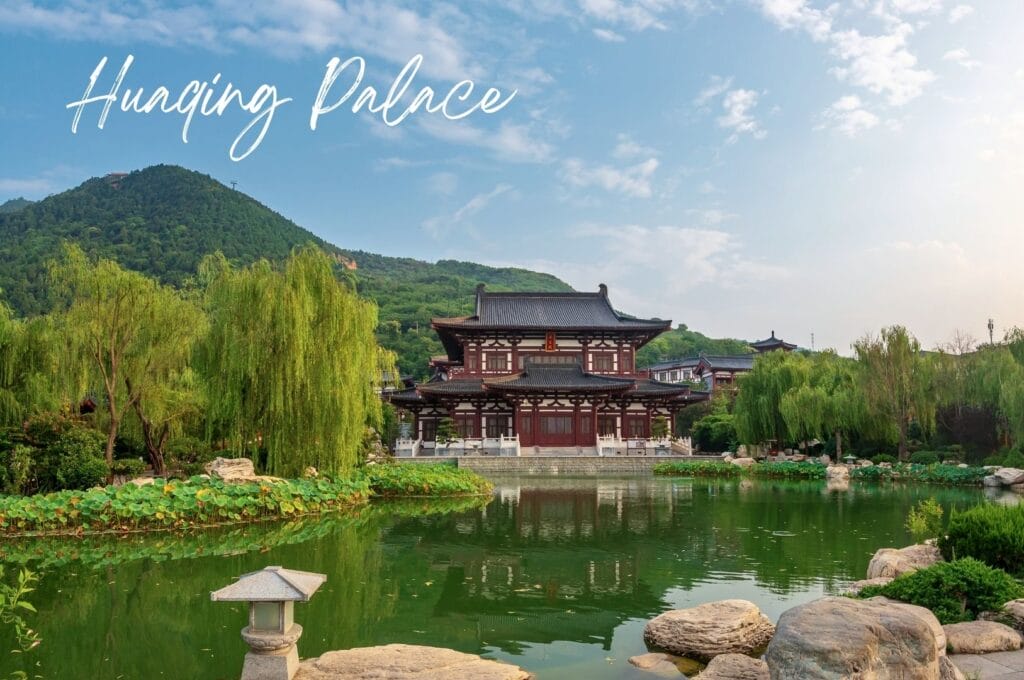
Attend a traditional show
In addition to the famous The Song of Everlasting Sorrow show, Xi’an showcases traditional dance shows retracing the history of the Tang Dynasty or the Silk Road.
The city’s most famous venue is the Tang Dynasty Theatre to attend a colorful and costumed 1-hour show. English subtitles help you grasp the full scope of Chinese civilization’s golden age.
The other option is to go to Tang Paradise (Datang Furong), 5 km south of the Big Wild Goose Pagoda, a brand new park that recreates Tang Dynasty architecture. This theme park is divided into several zones covering all cultural aspects of life during the imperial era. In addition to magnificent developments, Tang Paradise is also known for its nighttime shows! In short, it’s a good place for the whole family to discover this Chinese dynasty more playfully. The park is open every day from 9 a.m. to 10 p.m. and entry costs 120 yuan. To get there, take Xi’an metro line 4 and get off at Datangfurongyuan stop.
Visit the Han Yang Ling Museum (Hanyangling)
This museum’s specialty? Its terracotta figurines! Yes, you read correctly. We discovered this place’s existence after our backpacking trip to China and clearly, we would have wanted to go there! Sure, the main terracotta statues site remains that of Qin Shihuang’s mausoleum. But unlike the latter, here, in Emperor Jingdi‘s mausoleum from the Han Dynasty, you’re close to the statues by moving above the underground funeral pits. So you’re much closer. In this museum, there’s no army but rather scenes of daily life in the 2nd century BC, represented by tens of thousands of figurines representing animals, warriors, tools, servants…
- Hours: The museum is open every day from 8:30 a.m. to 6:30 p.m. in high season (March to November) and from 8:30 a.m. to 6 p.m. the rest of the year.
- How to get to Han Yang Ling Mausoleum: From Han Yan Ling high-speed train station (20 to 30 minutes by car from Xian North station).
- Fee: Entry costs 70 yuan in high season (March to November) and 50 yuan in low season (December to February). There are quite a few explanatory panels in English. You can also take a guide to accompany you (100 yuan).
Visit the Small Wild Goose Pagoda
As its name suggests, it’s the little sister of the Big Wild Goose Pagoda. Located less than 1 km south of the south gate and part of Jianfu Temple grounds, it’s much less crowded than its big sister! It’s surrounded by a very pretty park with century-old trees and the atmosphere is very peaceful. Park access is free and the Small Wild Goose Pagoda entrance ticket costs 30 yuan.
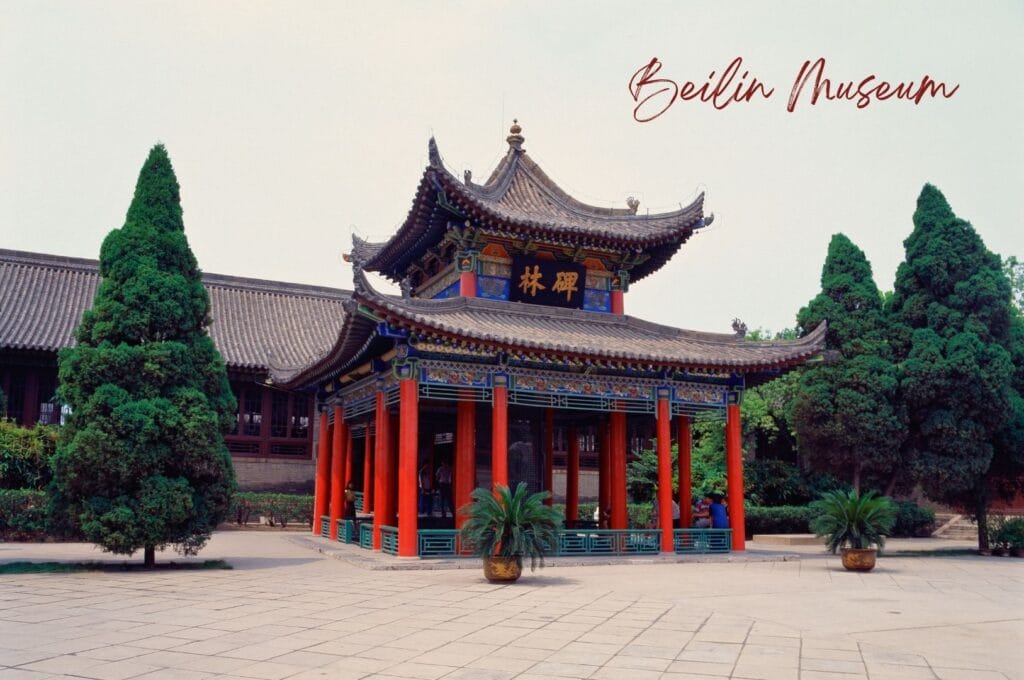
Stroll through the Forest of Stone Steles (Beilin Museum)
That’s a visit we didn’t do but would have really liked to do. Located next to the south gate of the ramparts and in a former Confucius temple, the Beilin Museum houses more than 3,000 Buddhist steles, most dating from the Tang Dynasty (7th century). In total, the exhibition of these relics covers 1,600 years of history! The most impressive is undoubtedly the Nestorian Stele, witness to Christianity’s early years in China. The exhibitions also trace the history and impact that Chinese calligraphy art has had over time.
If you want some peace and quiet and to learn more about cultural history, this is the museum for you ;).
- Opening hours: From December to February, the Beilin Museum is open from 8 a.m. to 6 p.m. In high tourist season (March to November), it’s open from 8 a.m. to 6:30 p.m.
- How to get to the Stele Forest: From downtown, go to the south gate of the wall. By metro, the station is Yongningmen on line 2.
- Fees: Entry costs 50 yuan in low season (December to February) and 75 yuan in high season. You can buy a combination ticket for 100 yuan to visit the old town ramparts.
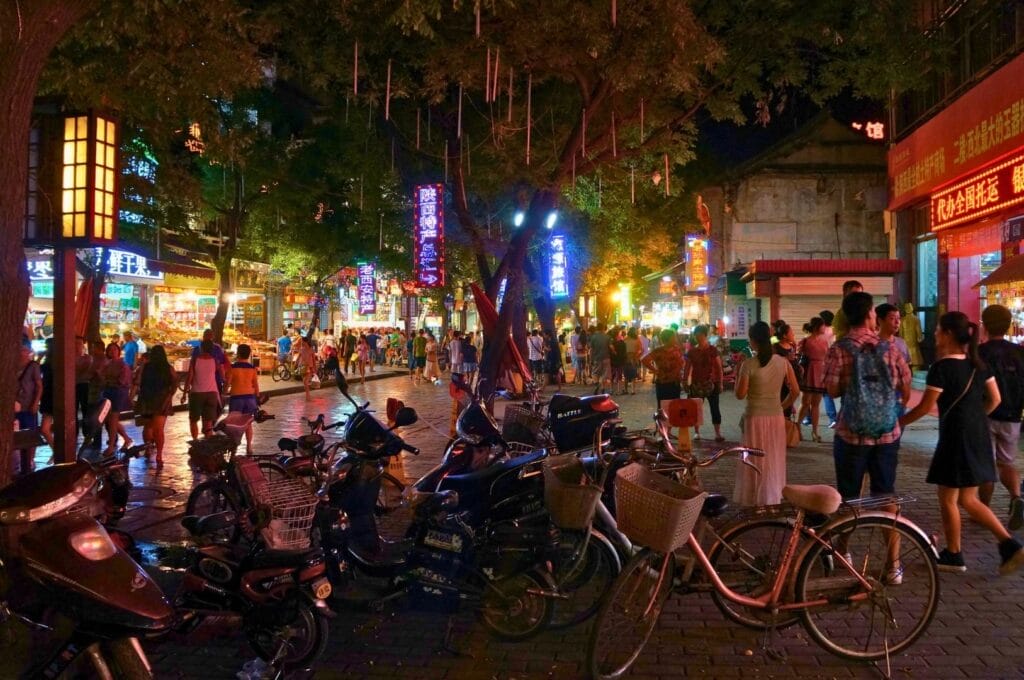
Quick review after more than 2 weeks of travel in China
- Number of days sick: 0 (we’re knocking on wood for it to continue)
- Weight: no scale available, but a little less belly on the horizon…
- Number of unidentifiable meals: 3, including once where we’re pretty sure we had dog… Ouch!
- Number of burps and spits heard: we stopped counting a long time ago… Sorry!
- Number of bowls of instant noodles: 3! Not expensive (0.5 euro), but quite difficult to identify the contents…
To learn more about our recap, we recommend reading our article dedicated to our travel budget in China :).
The People’s Republic of China, like many other countries in the world, requires a visa to enter the territory. To obtain this precious document, you need to prove several things: accommodation reservations, exit tickets from the country, etc. One of the essential points for obtaining the visa is also having travel insurance. If you don’t have one yet, feel free to check out our selection of the best travel insurance.
There you have it, you know everything about our visit to Xi’an! Do you have other recommendations? See you in the next article, where we’ll tell you about hiking routes of Mount Hua! Our calves and glutes still remember it ;).
P.S.: We’ve put together a complete guide to prepare your trip to China (tips, itinerary, transport…).
Pin it
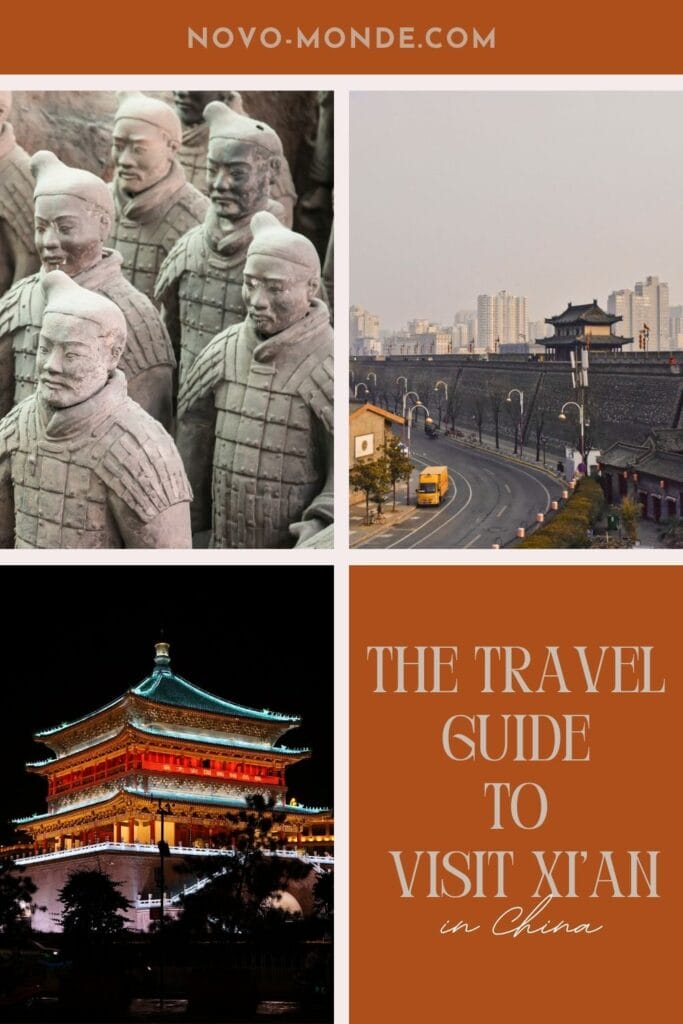
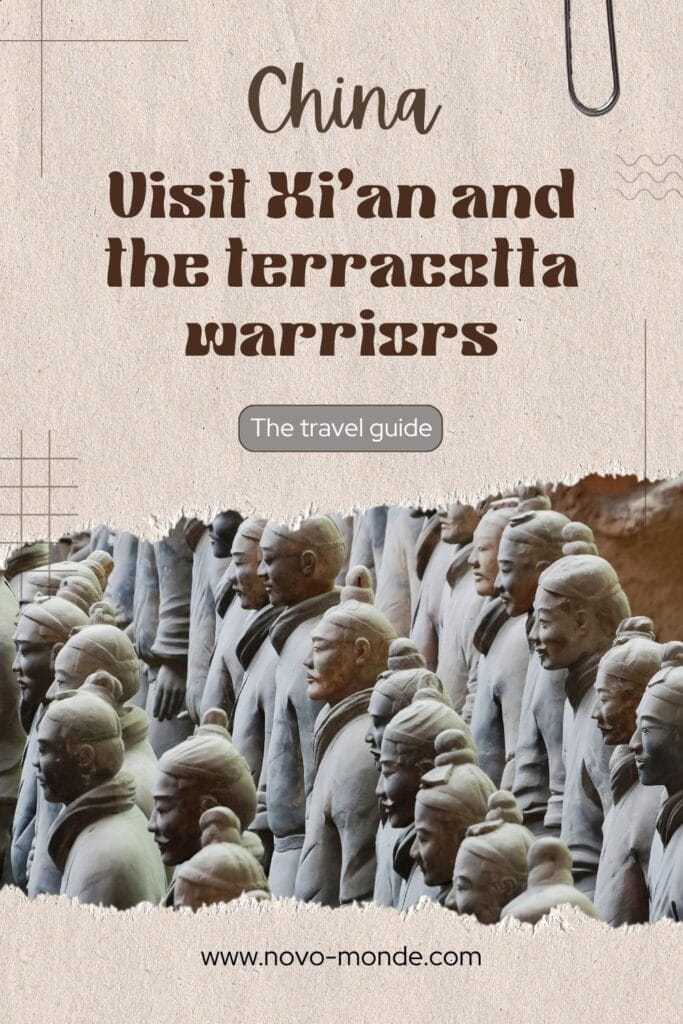


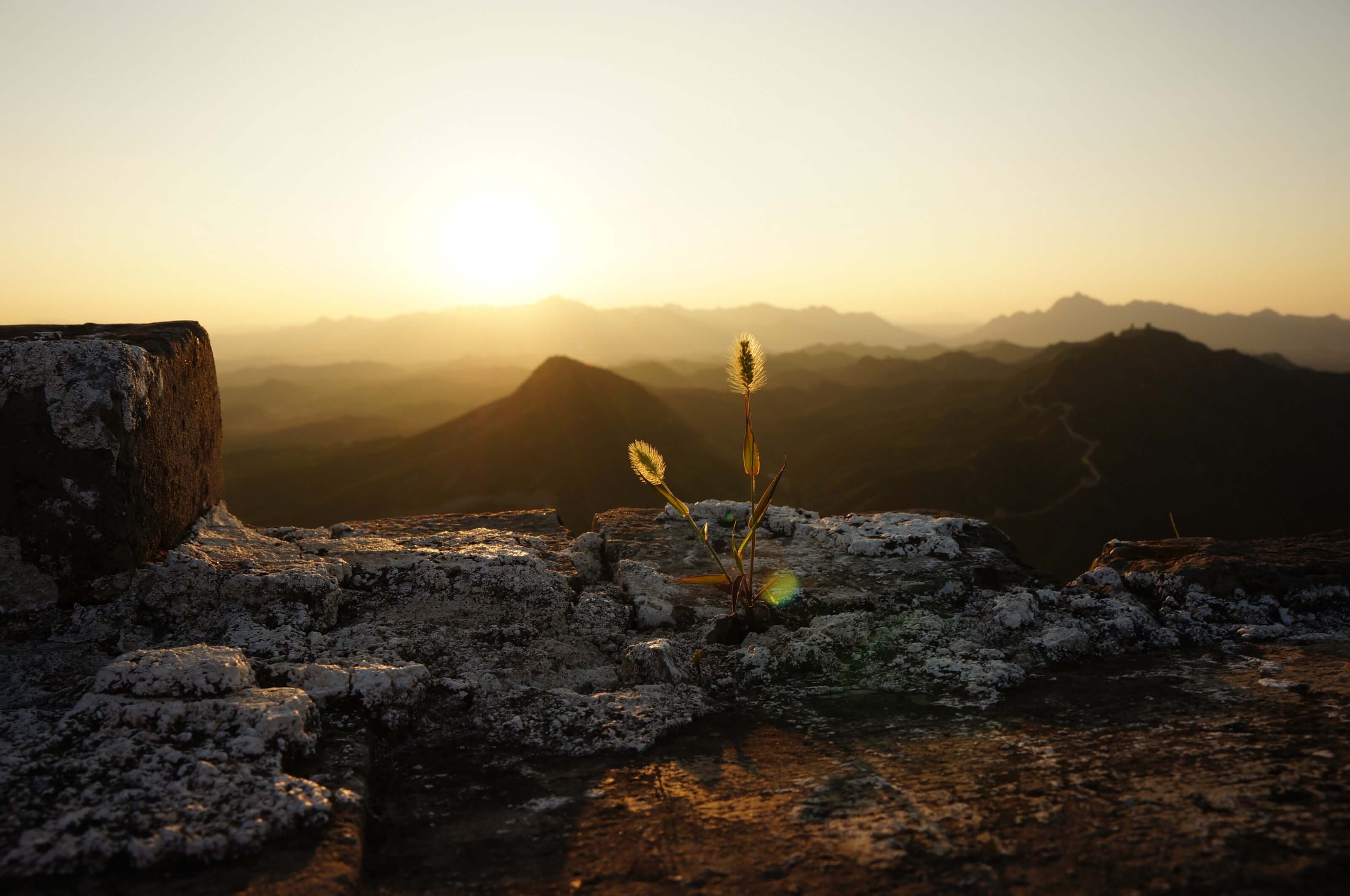
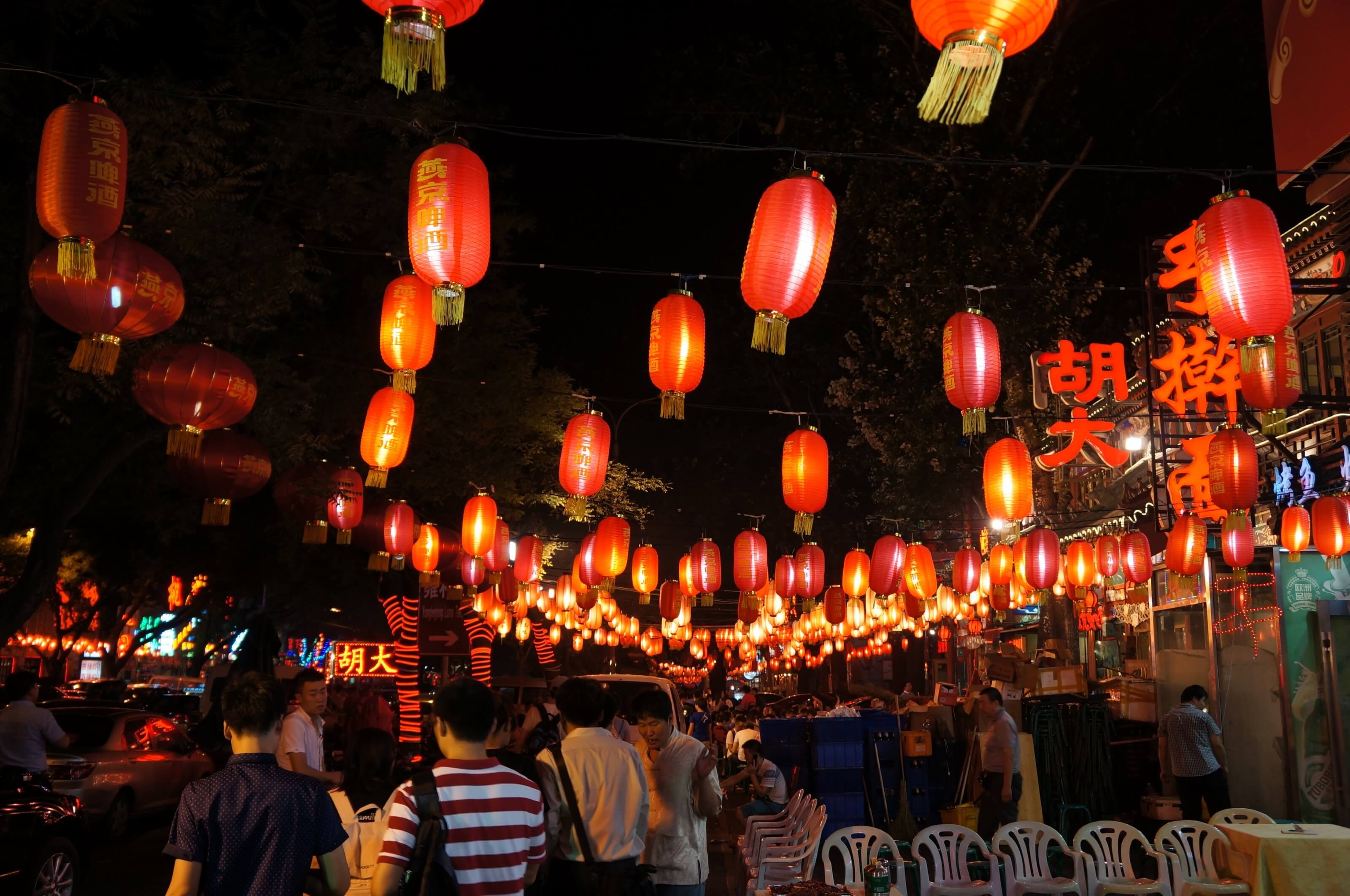
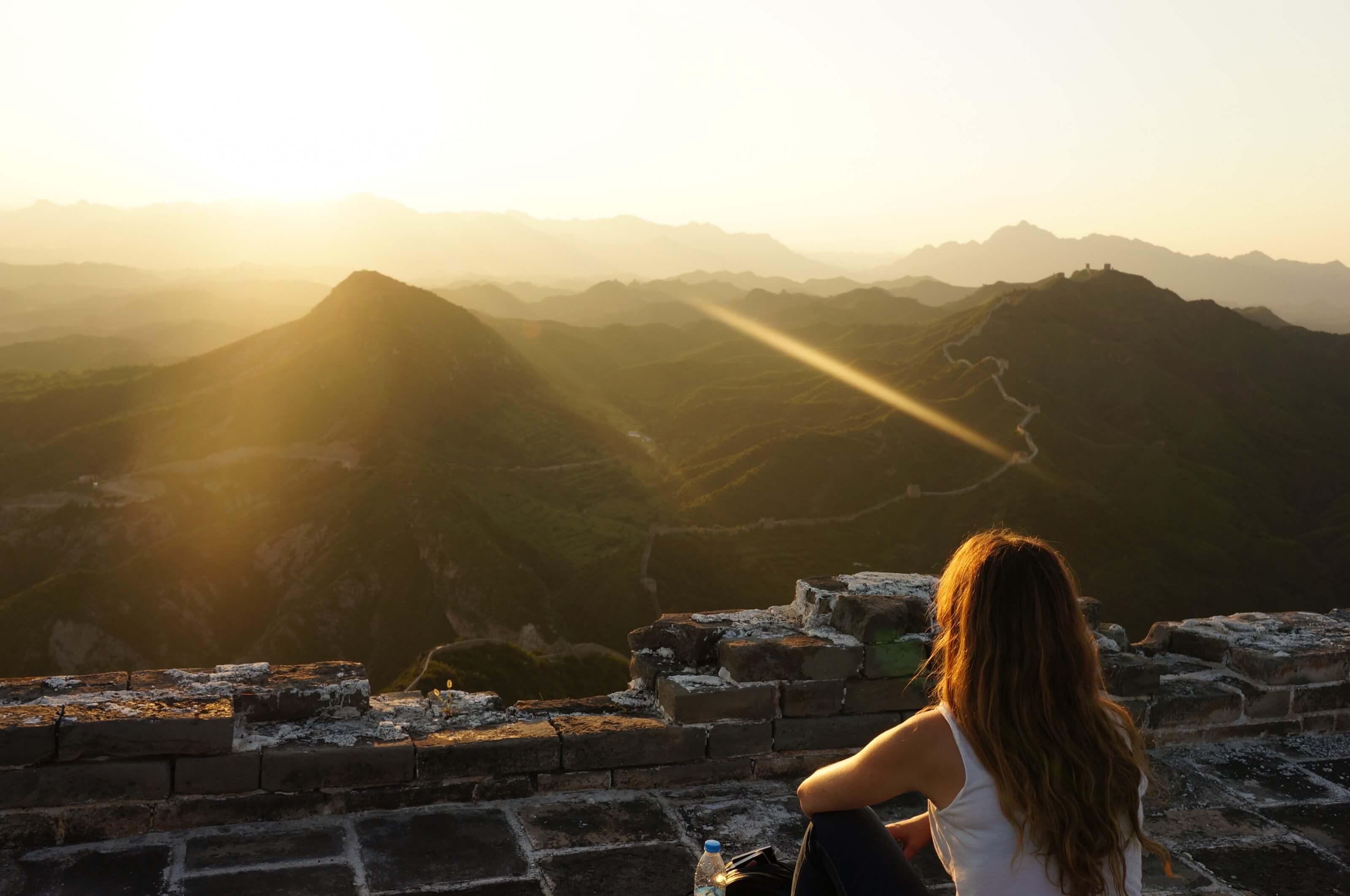
Join the discussion